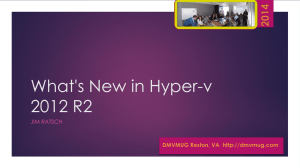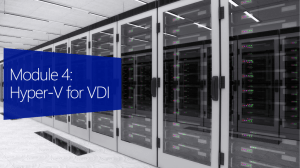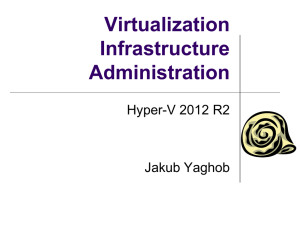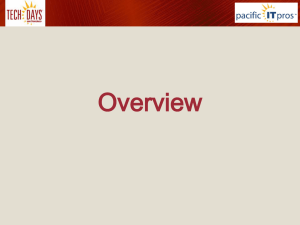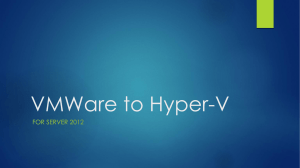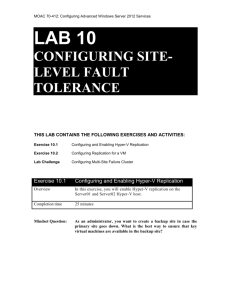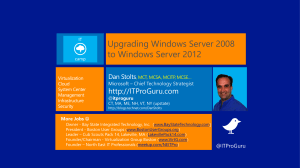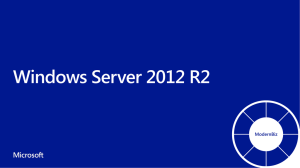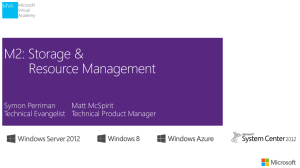With Windows Server 2012, Hyper-V…
advertisement
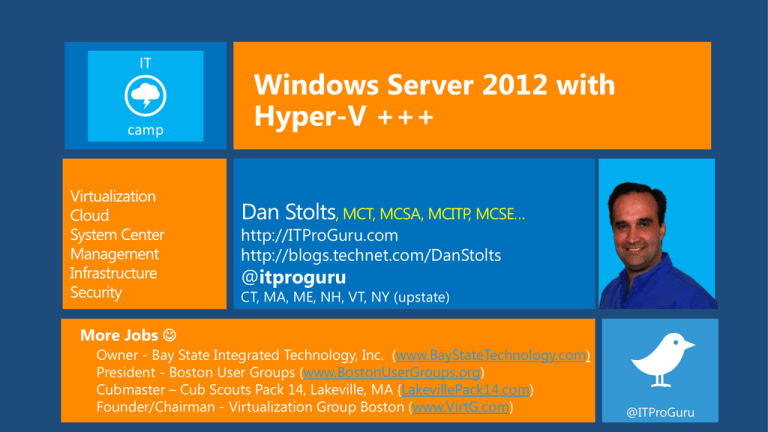
, MCT, MCSA, MCITP, MCSE…
http://ITProGuru.com
http://blogs.technet.com/DanStolts
@itproguru
CT, MA, ME, NH, VT, NY (upstate)
More Jobs
Owner - Bay State Integrated Technology, Inc. (www.BayStateTechnology.com)
President - Boston User Groups (www.BostonUserGroups.org)
Cubmaster – Cub Scouts Pack 14, Lakeville, MA {LakevillePack14.com)
Founder/Chairman - Virtualization Group Boston (www.VirtG.com)
@ITProGuru
Download Process Walkthrough
Windows 2012
Hyper-V Server 2012
System Center 2012
System Center 2012 SP1
Infrastructure As A Service
Windows 8
This Slide Deck
http://ITProGuru.com/resources
1
Hyper-V Network
Virtualization
2
Shared-nothing live
migration
6
Hardware
offloading
3
Virtual Fibre
Channel
Cluster
enhancements
Massive scale
7
4
8
Guest NUMA
support
5
Hyper-V Replica
9
Runtime memory
configuration
10
Hyper-V network
switch
Hyper-V Expanded Processor
& Memory Support
Maximum Number
System
Host
Virtual Machine
Cluster
Resource
Logical processors on
hardware
Windows Server 2008 Windows Server 2012
R2
Improvement Factor
64
320
5x
Physical Memory
1 TB
4 TB
4x
Virtual processors per host
512
2,048
4x
Virtual processors per virtual
machine
4
64
16x
Memory per virtual machine
64 GB
1 TB
16x
Active virtual machines per
server
384
1,024
2.7x
Nodes
16
64
4x
1,000
8,000
8x
Virtual machines
What is Hyper-V Replica?
A virtual machine level replication solution which efficiently replicates data over a
LAN/WAN to a remote (Replica) site without relying on software or hardware
technologies outside of the Windows Server 2012 operating system
New in Windows Server 2012 Hyper-V Role
Storage and Workload agnostic
Replica Servers can be standalone or a Failover Cluster
Servers can be members of a workgroup or a domain (same or
different); Primary and Replica servers do not need to be in the
same domain unless part of a Failover Cluster
• Managed locally (Hyper-V Manager) or remotely (Hyper-V Remote
Server Administration Tools (RSAT) or System Center Virtual Machine
Manager (SCVMM)
• 4 Deployment Scenarios
• Head Office and Branch Office (HO-BO)
• Enterprise Datacenter
• Hosting Provider Datacenter
• Customer Office and Hosting Provider Datacenter (Cross-Premise)
•
•
•
•
Hyper-V Replica & Failover Clustering
• Failover Clusters can participate in replication, but only as a single replication server.
• Failover Clusters have a new clustered role, the Hyper-V Replica Broker
• Highly-Available role that moves between nodes
• One instance per cluster
• Changes traditional Hyper-V multi-site (disaster recovery) Failover Clustering. Previously
replication across sites was done between nodes within a single cluster.
• Primary and Replica servers do not need to be in the
same domain unless part of a Failover Cluster
• Replication Scenarios
• Cluster to Cluster
• Cluster to Standalone
• Standalone to Cluster
• Standalone to Standalone
Hyper-V over SMB
Server Message Block (SMB) protocol…
• Is a network file sharing protocol that allows applications on a computer to read
and write to files and to request services from server programs in a computer
network
• Windows Server 2012 introduces the new 3.0 version of the SMB protocol
With Windows Server 2012, Hyper-V…
• Can store virtual machine files (configuration, VHD, snapshots) in files shares
over the SMB 3.0 protocol
• Is supported for both stand-alone and clustered servers that use Hyper-V with
shared file storage for the cluster
• Can support scale-out file shares and clusters
• Can leverage SMB Multi-Channel
Live Migration – Moving a Running
VM without Shared Storage
standard Ethernet connection
1. Live Migration setup
occurs
2. Memory pages are
transferred from the
source server to the
destination server
3. Modified pages are
transferred to
destination server
4. State is transferred to
destination server
5. VM brought online on
destination server
6. Network cleanup
occurs
Windows Server 2012 Hyper-V
Scalability Improvements
•
•
•
•
•
•
•
•
•
Expanded processor and memory support
Virtual Non-Uniform Memory Access (NUMA)
Network Adapter Hardware Acceleration
Offload Data Transfer (ODX)
Support for 4 KB sector disks
Virtual Fibre Channel
SMB 3.0
Improved VM Import
VHDX disk format
Comparison
System
Host
Windows Server
2012 RC Hyper-V
VMware
ESXi 5.0
VMware vSphere
5.0 Enterprise Plus
Logical Processors
320
160
160
Physical Memory
4TB
32GB1
2TB
Virtual CPUs per Host
2,048
2,048
2,048
Virtual CPUs per VM
64
8
322
1TB
32GB1
1TB
1,024
512
512
Guest NUMA
Yes
Yes
Yes
Maximum Nodes
64
N/A3
32
4,000
N/A3
3,000
Resource
Memory per VM
VM
Active VMs per Host
Cluster
Maximum VMs
VMware ESXi 5.0 is a free download yet has the following restrictions:
1.
2.
3.
Host physical memory is capped at 32GB thus maximum VM memory is also restricted to 32GB
usage.
vSphere 5.0 Enterprise Plus is the only edition that supports 32 vCPUs. All others support 8
vCPUs within a virtual machine.
For clustering/high availability, customers must purchase vSphere
10
VHDX Disk Format
New default .VHDX format for VHDs in Hyper-V in Windows Server 2012
• Supports virtual disks up to 64 TB
• Aligns to megabyte boundaries to support large sector disks (4 KB
sector disks)
• Uses large block sizes to provide better performance
• Includes a new log to protect from corruption due to power failure
• Has much greater resiliency
• Allows for embedded custom user-defined metadata into VHDX files
Storage Spaces & Thin
Provisioning?
Storage Spaces
• New in Windows Server 2012
• Provides an in-box storage virtualization that can use low-cost commodity storage devices
• Aggregates unallocated space on physical disks installed in or connected to servers through
a “pooling” model
• Can provide a cost-effective platform for business critical storage across a variety of
scenarios
Thin Provisioning
• “Just-in-Time” allocations of storage with the ability to reclaim storage (“Trim”)
• Integrated with Storage Spaces
Deduplication
• Capacity Optimization
• Scale and Performance
• Reliability and Data Integrity
Hyper-V Over SMB Workflow
1. Install the Hyper-V role on a Windows Server 2012 machine
2. Install the File Services role on a Windows Server 2012 machine
3. Create an SMB file share
4. Create a virtual machine and virtual machine hard disk on the file share
5. Migrate existing virtual machine storage to the file share
Microsoft Virtual Academy (MVA)
http://AKA.MS/GuruMVA Free Online Training
dstolts@microsoft.com
http://ItProGuru.com
Bob Familiar, my manager, would love your feedback on today’s event.
He wants to know what impact todays event has on you and your business
You can e-mail him at: Bob.Familiar@microsoft.com
@ITProGuru
Aka.ms/GuruMVA
DOWNLOAD
Windows Server
2012 Release
Candidate
DOWNLOAD
Microsoft System
Center 2012
Evaluation
Aka.ms/getwin2012
Aka.ms/getsc2012
Infrastructure As A Service
http://aka.ms/guruMVA

